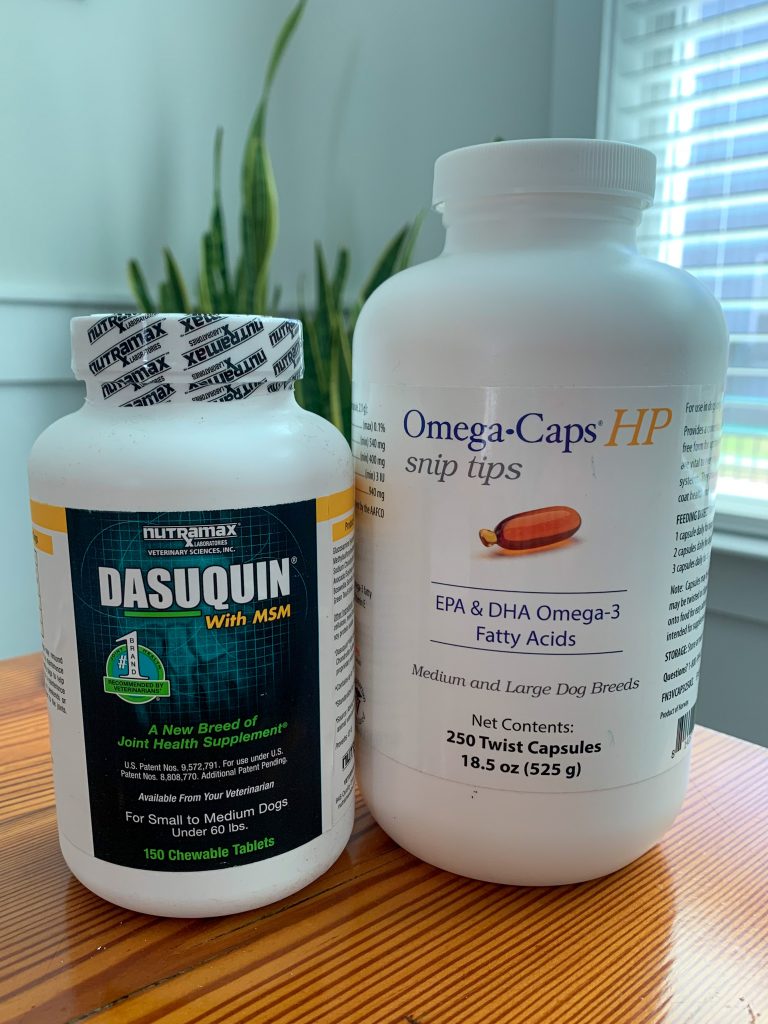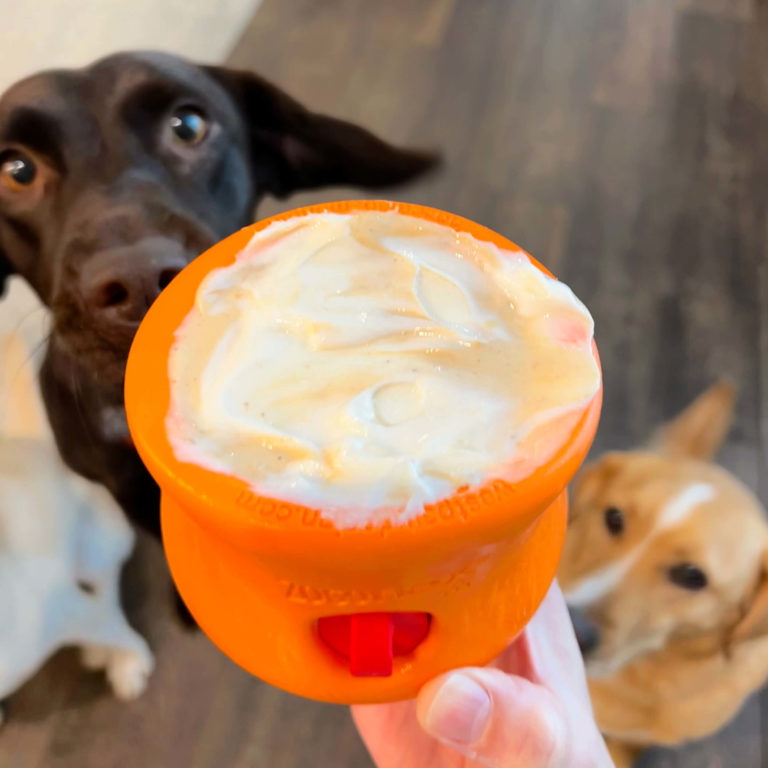What is the Safest Anti-Inflammatory for Dogs?
What is the safest anti-inflammatory for dogs? When it comes to NSAID use (non-steroidal anti-inflammatory drug) for pain management, I hold a double standard for me and my dogs. I don’t think twice about popping an ibuprofen for any little ache or pain I may have. But I will exhaust every. last. alternative. to manage pain for my dogs caused by inflammation. NSAIDs are not your only option for anti-inflammatory benefits.
My experience using nSAIDS
When my husband and I got our first dogs, we thought we were prepared for everything. I’d heard Golden Retrievers were more predisposed to having hip dysplasia, and that large dogs are more prone to osteoarthritis as they age. I kept each of the boys at a healthy weight, and I started them on joint supplements and fish oil, as preventative measures.

Around six years old, Cedric started to slow down a bit. Our vet at the time recommended we try an NSAID to reduce the joint inflammation. I’d heard stories about NSAID use causing stomach ulcers in dogs, so I was hesitant to try them. But eventually I caved in, and tried an NSAID for his pain management.
It was remarkable! The NSAID gave Cedric so much relief! He was much more like the active dog he’d always been. I was pleased with the change I saw in him, and thought the NSAID was the right choice after all.
It was not a happy ending
But the relief was short lived. Soon Cedric was having difficulty taking our full evening walks. I began sitting with him on a bench along the way, while my husband would continue on with Skip, our other dog. Turns out it wasn’t the arthritis slowing Cedric down.
One morning, Cedric shot out of bed, crying out in pain. He began pacing and appeared anxious. It was a Sunday, so off we went to the emergency vet. Initially, they couldn’t really find anything wrong, and we were sent home to keep an eye on him. He rapidly declined, and we returned later that day. Long story short, Cedric had a perforated peptic ulcer.

They called in a surgeon, and she tried to repair the hole. The specifics are long forgotten, but the perforation occurred in area that was extremely difficult to repair. Cedric survived the surgery, but he never came home. He died five days later. We were devastated, and I blamed myself for choosing to give him an NSAID.
Alternatives to nsaids for pain management in dogs
What is a safe alternative to NSAIDs for anti-inflammatory pain management in dogs? First and foremost, this post is not to be construed as medical advice. Always consult with your veterinarian when diagnosing, or choosing a treatment plan, for your dog. It is not wrong to give your dog an NSAID for pain management. There are scenarios where the benefit may outweigh the risks. But due to my experience of losing Cedric to a perforated peptic ulcer caused by NSAID use, I have relied heavily on alternative methods when it comes to pain management for my dogs. I think I might have tried everything!

Subscribe now
For our latest
tips & tricks for
life with dogs!
Preventative measures
An ounce of prevention is worth a pound of cure. Keep your dog at a healthy weight. Canine obesity contributes to additional wear and tear on your dog’s joints, increased levels of inflammation, and a host of other diseases. Ask your veterinarian about your dog’s Body Condition Score. If your dog is not in the ideal range, it’s time to cut back on the treats.
Consider adding supplements for your dog’s joint health. Glucosamine and Chondroitin may help prevent or slow the breakdown of cartilage associated with osteoarthritis. Other supplements with anti-inflammatory benefits include MSM (Methylsulfonylmethane) and fish oil. In addition to fish oil, the girls take Dasuquin chewable tablets with MSM, Glucosamine, and Chondroitin.

drug alternatives to NSAIDs
Adequan Canine is an FDA-approved disease-modifying osteoarthritis drug (DMOAD). What is a DMOAD, you ask? It’s a drug that actually prevents the progression of osteoarthritis, as opposed to just treating the symptoms. Available by prescription only, and given by intramuscular injection, Adequan works by preventing joint degradation, reducing inflammation, and improving synovial fluid for better joint mobility.
Talk to your veterinarian about other drug alternatives to NSAIDs for pain management. There are other options, and your veterinarian can guide you on what option may be best for your dog. Personally, I found Gabapentin to be the right choice for my dogs when additional drug therapy was needed for pain management.
UPDATE 01/04/2024: There is a new drug in the veterinary world for controlling the pain of osteoarthritis in dogs. It’s called Librela and so far, I’ve only heard very good things! Definitely ask your veterinarian if Librela is the right choice for your dog.
Canine physical Therapy
Do dogs need physical therapy for pain management? Physical therapy can help your dog improve strength, flexibility, and balance. Speak with your veterinarian, or visit a Certified Canine Rehabilitation Therapist (CCRT) to learn more about how PT can help your dog.

For Cedric’s successor Ginger, hydrotherapy (underwater treadmill) was a key treatment. She had osteoarthritis, and a protruding disc in her spine. We would swim regularly to allow her low impact exercise. However, the onset of seizures, and a diagnosis of Wobbler Syndrome, made it unsafe for her to swim anymore. Incorporating hydrotherapy into Ginger’s routine allowed her to maintain muscle mass, while minimizing the discomfort that she was feeling outside of the water.
Ginger, working on her fitness
Other treatments Ginger received at physical therapy included heat/cold therapy, as well as cold laser therapy. And just like PT for yourself, we had a list of exercises to work on at home, and instructions for using both heat and ice to control inflammation. Ginger had this lavender scented “spa wrap” that could be microwaved or frozen. Her sister Lily was extremely jealous and would insist on getting her own spa treatment every evening too! 😂

Canine Massage Therapy
So, maybe this is really where ‘Affluent Dogs’ was born. Ginger had an in-home Certified Canine Massage Therapist. I don’t even have my own massage therapist! But I digress…
Canine massage therapy is not just petting dogs! Like massage therapy for people, dogs can benefit from soft tissue manipulation to relax muscle tissue, reduce nerve compression, increase circulation, and ultimately relieve pain.
How often do dogs need a massage? It will depend on the issue(s) you’re trying to manage. Ginger got bi-weekly massages, but honestly, I think that was more about what I was able to afford at the time. Your CCMT can recommend the frequency most appropriate for your dog’s condition.
Canine Acupuncture
Speaking of pain management alternatives that benefit both people and pets, acupuncture for dogs is a non-drug alternative for pain management, based in Traditional Chinese Medicine. Acupuncture involves inserting tiny needles into acupressure points to balance energy flow in the body, allowing the body to heal.
Does acupuncture for dogs really work? Personally, I felt acupuncture improved Ginger’s mobility and made her feel more comfortable during her last year.

Western medicine indicates acupuncture may relieve pain because stimulation of the acupressure points releases endorphins, the body’s natural pain killers. Whether you subscribe to the Eastern medicine philosophy or not, there is plenty of evidence that acupuncture is an excellent alternative choice for your dog’s pain management.
Products and practitioners I use
- Cutler Animal Hospital
- Chi on Wheels
- PAWsitive Wellness Canine Massage
- Physical Rehabilitation at CVRC
- Adequan Canine
- Dasuquin Chewable Tablets with MSM
- Fish oil: 3V Caps HP Snip Tips for Medium and Large Dogs, 250 Capsules
You might also enjoy:
Disclaimer
One more time for folks in the back, I am not a veterinarian. This post involves my direct experience using an NSAID drug to treat osteoarthritis in my dog, as well as all of the alternative pain management therapies I’ve elected to use for my dogs. I am not advising that you should, or should not, use any of the treatment options I’ve described here. I am simply sharing my experience, so you have ideas to discuss with your own veterinarian when making decisions about pain management for your dog.





